
- •Explanation
- •1. Flash (the default location) 2. Tftp server 3. Rom (used if no other source is found)
- •Question 3
- •In a switched environment, what does the ieee 802.1q standard describe?
- •Question 8
- •Question 3
- •Vlan 3 is not yet configured on your switch. What happens if you set the switchport access vlan 3 command interface configuration mode?
- •Explanation
- •In the Frame Relay network, which ip addresses whould be assigned to the interfaces with point-to-point pvCs?
- •It has become necessary to configure an existing serial interface to accept a second Frame Relay virtual circuit. Which of the following are required to solve this? (Choose three)
- •If ip routing is enabled, which two commands set the gateway of last resort to the default gateway? (Choose two)
- •Question 8
- •Explanation
- •Explanation
- •If the startup-config file is missing or does not specify a location, it will check the following locations for the ios image:
- •Question 4
- •Explanation
- •Explanation
If ip routing is enabled, which two commands set the gateway of last resort to the default gateway? (Choose two)
A. ip default-gateway 0.0.0.0 B. ip route 172.16.2.1 0.0.0.0 0.0.0.0 C. ip default-network 0.0.0.0 D. ip default-route 0.0.0.0 0.0.0.0 172.16.2.1 E. ip route 0.0.0.0 0.0.0.0 172.16.2.1
Answer: C E
Question 7
Refer to the exhibit. A network administrator attempts to ping Host2 from Host1 and receives the results that are shown. What is a possible problem?

A. The link between Host1 and Switch1 is down. B. TCP/IP is not functioning on Host1 C. The link between Router1 and Router2 is down. D. The default gateway on Host1 is incorrect. E. Interface Fa0/0 on Router1 is shutdown. F. The link between Switch1 and Router1 is down.
Answer: C
Explanation
In this question, Host1 wants to ping Host2 but it receives a reply from the interface Fa0/0 of Router1 (10.1.1.1/24) that the “destination host unreachable”.
If the link between Host1 and Switch1 is down or the link between Switch1 and Router1 is down then Host1 can not receive this reply -> A and F are not correct.
Host1 can receive a reply from 10.1.1.1 -> the TCP/IP is working properly -> B is not correct.
For answer D, if the default gateway was not configured correctly on Host1 (in this case the default gateway should be 10.1.1.1/24) then 10.1.1.1 can not receive the ping packets from Host1 and can not reply for Host1 that the destination is unreachable -> D is not correct.
Interface Fa0/0 on Router1 replies for the ping packets from Host1 so it is up -> E is not correct. If the interface Fa0/0 on Router is shutdown then we will receive a message of “Request timed out”, not “Destination host unreachable”.
Answer C is correct because we can get a reply from the interface Fa0/0 of Router1 so the link between Host1 and Router1 should be fine -> the problem lies at the other side of Router1. But if the link between Router2 and Host2 is down then we will receive a reply from interface S0/1 of Router2 that the “destination host unreachable”. Therefore the problem can just be the link between Router1 and Router2.
Question 8
Refer to the exhibit. The network administrator requires easy configuration options and minimal routing protocol traffic. Which two options provide adequate routing table information for traffic that passes between the two routers and satisfy the requests of the network administrator? (choose two)

A. a dynamic routing protocol on InternetRouter to advertise summarized routers to CentralRouter. B. a dynamic routing protocol on CentralRouter to advertise summarized routers to InternetRouter. C. a static route on InternetRouter to direct traffic that is destined for 172.16.0.0/16 to CentralRouter. D. a dynamic routing protocol on InternetRouter to advertise all routes to CentralRouter. E. a dynamic routing protocol on CentralRouer to advertise all routes to InternetRouter F. a static, default route on CentralRouter that directs traffic to InternetRouter.
Answer: C F
Question 9
Refer to the graphic. A static route to the 10.5.6.0/24 network is to be configured on the HFD router. Which commands will accomplish this? (Choose two)
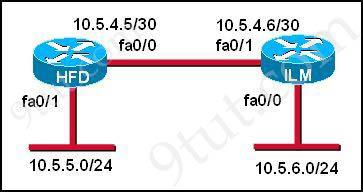
A. HFD (config) #ip route 10.5.6.0 0.0.0.255 fa0/0 B. HFD(config)# ip route 10.5.6.0 0.0.0.255 10.5.4.6 C. HFD(config)# ip route 10.5.6.0 255.255.255.0 fa0/0 D. HFD(config)# ip route 10.5.6.0 255.255.255.0 10.5.4.6 E. HFD(config)# ip route 10.5.4.6 0.0.0.255 10.5.6.0 F. HFD(config)# ip route 10.5.4.6 255.255.255.0 10.5.6.0
Answer: C D
Explanation
The simple syntax of static route:
ip route destination-network-address subnet-mask {next-hop-IP-address | exit-interface} + destination-network-address: destination network address of the remote network + subnet mask: subnet mask of the destination network + next-hop-IP-address: the IP address of the receiving interface on the next-hop router + exit-interface: the local interface of this router where the packets will go out
In the statement “ip route 10.5.6.0 255.255.255.0 fa0/0″:
+ 10.5.6.0 255.255.255.0: the destination network + fa0/0: the exit-interface
CCNA IP Routing 2
Question 1
Users on the 172.17.22.0 network cannot reach the server located on the 172.31.5.0 network. The network administrator connected to router Coffee via the console port, issued the show ip route command. Based on the output of the show ip route command and the topology shown in the graphic, what is the cause of the failure?
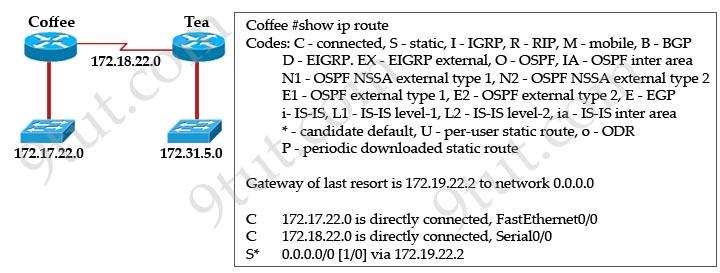
A. The network has not fully converged. B. IP routing is not enabled. C. A static route is configured incorrectly. D. The FastEthernet interface on Coffee is disabled. E. The neighbor relationship table is not correctly updated. F. The routing table on Coffee has not updated.
Answer: C
Explanation
There are no dynamic routing protocols running on Coffee router, only a default route is configured to route all traffic to 172.19.22.2 but we don’t know about this network. The correct IP address should be the IP address on the interface of Tea router which is connected to Coffee router (maybe 172.18.22.2).
Question 2
The speed of all serial links is E1 and the speed of the all other links is 100Mb/s. A static route will be established on the Manchester router to direct traffic toward to the internet over the most direct path available. What configuration of the Manchester router will establish a route toward to the internet for traffic from workstation on the Manchester LAN?
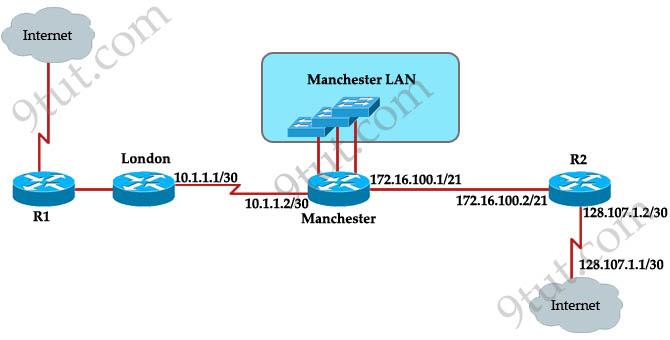
A. ip route 0.0.0.0 255.255.255.0 172.16.100.2 B. ip route 0.0.0.0 255.255.255.252 128.107.1.1 C. ip route 0.0.0.0 0.0.0.0 128.107.1.1 D. ip route 0.0.0.00.0:0:0 172.16.100.1 E. ip route 0.0.0.0 255.255.255.255 172.16.100.2 F. ip route 0.0.0.0 0.0.0.0 172.16.100.2
Answer: F
Explanation
Maybe “the most direct path available” here means via R2 because it is directly connected with the Internet while the London path needs to go through R1. So we need a command to send traffic to R2 and the correct command is “ip route 0.0.0.0 0.0.0.0 172.16.100.2″.
Question 3
Which two are advantages of static routing when compared to dynamic routing? (choose two)
A. Security increases because only the network administrator may change the routing tables. B. Configuration complexity decreases as network size increases. C. Routing updates are automatically sent to neighbors. D. Route summarization is computed automatically by the router. E. Routing traffic load is reduced when used in stub network links. F. An efficient algorithm is used to build routing tables using automatic updates. G. Routing tables adapt automatically to topology changes.
Answer: A E
Question 4
Refer to the exhibit. According to the routing table, where will the router send a packet destined for 10.1.5.65?
|
Network |
Interface |
Next-hop |
|
10.1.1.0/24 |
e0 |
directly connected |
|
10.1.2.0/24 |
e1 |
directly connected |
|
10.1.3.0/25 |
s0 |
directly connected |
|
10.1.4.0/24 |
s1 |
directly connected |
|
10.1.5.0/24 |
e0 |
10.1.1.2 |
|
10.1.5.64/28 |
e1 |
10.1.2.2 |
|
10.1.5.64/29 |
s0 |
10.1.3.3 |
|
10.1.5.64/27 |
s1 |
10.1.4.4 |
A. 10.1.1.2 B. 10.1.2.2 C. 10.1.3.3 D. 10.1.4.4
Answer: C
Explanation
The destination IP address 10.1.5.65 belongs to 10.1.5.64/28, 10.1.5.64/29 & 10.1.5.64/27 subnets but the “longest prefix match” algorithm will choose the most specific subnet mask -> the prefix “/29″ will be chosen to route the packet. Therefore the next-hop should be 10.1.3.3 -> C is correct.
Question 5
Which destination addresses will be used by Host A to send data to Host C? (Choose two)
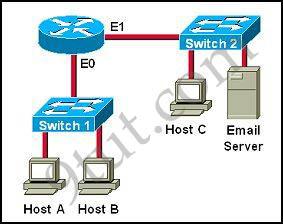
A. the IP address of Switch 1 B. the MAC address of Switch 1 C. the IP address of Host C D. the MAC address of Host C E. the IP address of the router’s E0 interface F. the MAC address of the router’s E0 interface
Answer: C F
Explanation
While transferring data through many different networks, the source and destination IP addresses are not changed. Only the source and destination MAC addresses are changed. So in this case Host A will use the IP address of Host C and the MAC address of E0 interface to send data. When the router receives this data, it replaces the source MAC address with it own E1 interface’s MAC address and replaces the destination MAC address with Host C’s MAC address before sending to Host C -> C and F are correct.
Question 6
Refer to the exhibit. The network administrator must establish a route by which London workstations can forward traffic to the Manchester workstations. What is the simplest way to accomplish this?
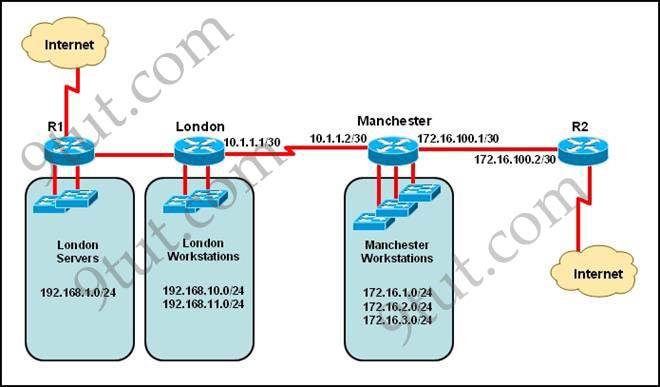
A. Configure a dynamic routing protocol on London to advertise all routes to Manchester. B. Configure a dynamic routing protocol on London to advertise summarized routes to Manchester. C. Configure a dynamic routing protocol on Manchester to advertise a default route to the London router. D. Configure a static default route on London with a next hop of 10.1.1.1. E. Configure a static route on London to direct all traffic destined for 172.16.0.0/22 to 10.1.1.2. F. Configure Manchester to advertise a static default route to London.
Answer: E
Question 7
Which parameter can be tuned to affect the selection of a static route as a backup when a dynamic protocol is also being used?
A. link bandwidth B. hop count C. link cost D. administrative distance E. link delay
Answer: D
Question 8
Refer to the exhibit:
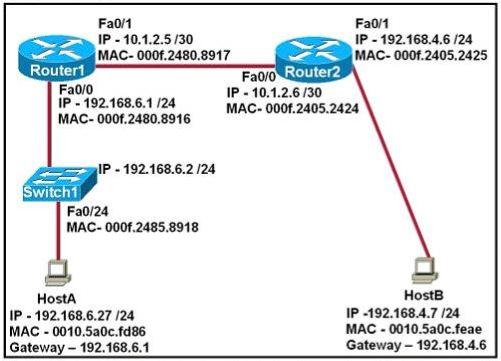
After HostA pings HostB, which entry will be in the ARP cache of HostA to support this transmission?
A.

B.

C.

D.

E.

F.

Answer: D
Explanation
Host A knows host B is in another network so it will send the pings to its default gateway 192.168.6.1. Host A sends a broadcast frame asking the MAC address of 192.168.6.1. These information (IP and MAC address of the default gateway) is saved in its ARP cache for later use.
CCNA DHCP Questions
Question 1
When a DHCP server is configured, which two IP addresses should never be assignable to hosts? (Choose two)
A. network or subnetwork IP address B. broadcast address on the network C. IP address leased to the LAN D. IP address used by the interfaces E. manually assigned address to the clients F. designated IP address to the DHCP server
Answer: A B
Explanation
Network or subnetwork IP address (for example 11.0.0.0/8 or 13.1.0.0/16) and broadcast address (for example 23.2.1.255/24) should never be assignable to hosts. When try to assign these addresses to hosts, you will receive an error message saying that they can’t be assignable.
Question 2
Which two tasks does the Dynamic Host Configuration Protocol perform? (Choose two)
A. Set the IP gateway to be used by the network. B. Perform host discovery used DHCPDISCOVER message. C. Configure IP address parameters from DHCP server to a host. D. Provide an easy management of layer 3 devices. E. Monitor IP performance using the DHCP server. F. Assign and renew IP address from the default pool.
Answer: C F
Question 3
Refer to the exhibit. Which rule does the DHCP server use when there is an IP address conflict?

A. The address is removed from the pool until the conflict is resolved. B. The address remains in the pool until the conflict is resolved. C. Only the IP detected by Gratuitous ARP is removed from the pool. D. Only the IP detected by Ping is removed from the pool. E. The IP will be shown, even after the conflict is resolved.
Answer: A
Question 4
How does a DHCP server dynamically assign IP address to host?
A. Addresses are allocated after a negotiation between the server and the host to determine the length of the agreement. B. Addresses are assigned for a fixed period of time. At the end of period, a new quest for an address must be made, and another address is then assigned. C. Addresses are leased to host. A host will usually keep the same address by periodically contacting the DHCP sever to renew the lease. D. Addresses are permanently assigned so that the host uses the same address at all times.
Answer: C
Question 5
Which statement is correct regarding the operation of DHCP?
A. A DHCP client uses a ping to detect address conflicts. B. A DHCP server uses a gratuitous ARP to detect DHCP clients. C. A DHCP client uses a gratuitous ARP to detect a DHCP server. D. If an address conflict is detected, the address is removed from the pool and an administrator must resolve the conflict. E. If an address conflict is detected, the address is removed from the pool for an amount of time configurable by the administrator. F. If an address conflict is detected, the address is removed from the pool and will not be reused until the server is rebooted.
Answer: D
Explanation
An address conflict occurs when two hosts use the same IP address. During address assignment, DHCP checks for conflicts using ping and gratuitous ARP. If a conflict is detected, the address is removed from the pool. The address will not be assigned until the administrator resolves the conflict.
(Reference: http://www.cisco.com/en/US/docs/ios/12_1/iproute/configuration/guide/1cddhcp.html)
CCNA OSPF Questions
Question 1
Which characteristics are representative of a link-state routing protocol? (Choose three)
A. provides common view of entire topology B. exchanges routing tables with neighbors C. calculates shortest path D. utilizes event-triggered updates E. utilizes frequent periodic updates
Answer: A C D
Question 2
Which statements describe the routing protocol OSPF? (Choose three)
A. It supports VLSM. B. It is used to route between autonomous systems. C. It confines network instability to one area of the network. D. It increases routing overhead on the network. E. It allows extensive control of routing updates F. It is simpler to configure than RIPv2.
Answer: A C E
Explanation
Answer A and C are obviously correct. For answer E, it allows extensive control of routing updates via Link-State Advertisement (LSA). Administrators can filter these LSAs to meet their requirements easily.
Question 3
A network administrator is trying to add a new router into an established OSPF network. The networks attached to the new router do not appear in the routing tables of the other OSPF routers. Given the information in the partial configuration shown below, what configuration error is causing this problem?
|
Router(config)# router ospf 1 Router(config-router)# network 10.0.0.0 255.0.0.0 area 0 |
A. The process id is configured improperly. B. The OSPF area is configured improperly. C. The network wildcard mask is configured improperly. D. The network number is configured improperly. E. The AS is configured improperly. F. The network subnet mask is configured improperly.
Answer: C
Question 4

A network associate has configured OSPF with the command: City(config-router)# network 192.168.12.64 0.0.0.63 area 0
After completing the configuration, the associate discovers that not all the interfaces are participating in OSPF. Which three of the interfaces shown in the exhibit will participate in OSPF according to this configuration statement? (Choose three)
A. FastEthernet0/0 B. FastEthernet0/1 C. Serial0/0 D. Serial0/1.102 E. Serial0/1.103 F. Serial0/1.104
Answer: B C D
Explanation
The “network 192.168.12.64 0.0.0.63″ equals to network 192.168.12.64/26. This network has: + Increment: 64 (/26= 1111 1111.1111 1111.1111 1111.1100 0000) + Network address: 192.168.12.64 + Broadcast address: 192.168.12.127 Therefore all interface in the range of this network will join OSPF -> B C D are correct.
Question 5
What is the default maximum number of equal-cost paths that can be placed into the routing of a Cisco OSPF router?
A. 16 B. 2 C. unlimited D. 4
Answer: D
Explanation
The default number of equal-cost paths that can be placed into the routing of a Cisco OSPF router is 4. We can change this default value by using “maximum-paths” command:
Router(config-router)#maximum-paths 2
Note: Cisco routers support up to 6 equal-cost paths
Question 6
Which two statements describe the process identifier that is used in the command to configure OSPF on a router? (Choose two)
Router(config)# router ospf 1 A. All OSPF routers in an area must have the same process ID. B. Only one process number can be used on the same router. C. Different process identifiers can be used to run multiple OSPF processes D. The process number can be any number from 1 to 65,535. E. Hello packets are sent to each neighbor to determine the processor identifier.
Answer: C D
Question 7
Why do large OSPF networks use a hierarchical design? (Choose three)
A. to confine network instability to single areas of the network. B. to reduce the complexity of router configuration C. to speed up convergence D. to lower costs by replacing routers with distribution layer switches E. to decrease latency by increasing bandwidth F. to reduce routing overhead
Answer: A C F
Explanation
Hierarchical design of OSPF (basically means that you can separate the larger internetwork into smaller internetworks called areas) helps us create a network with all features listed above (decrease routing overhead, speed up convergence, confine network instability to single areas of the network).
Question 8
Which commands are required to properly configure a router to run OSPF and to add network 192.168.16.0/24 to OSPF area 0? (choose two)
A. Router(config)#router ospf 1 B. Router(config)#router ospf 0 C. Router(config)#router ospf area 0 D. Router(config-router)#network 192.168.16.0 0.0.0.255 area 0 E. Router(config-router)#network 192.168.16.0 0.0.0.255 0 F. Router(config-router)#network 192.168.16.0 255.255.255.0 area 0
Answer: A D
Explanation
In the router ospf command, the ranges from 1 to 65535 so o is an invalid number -> A is correct but B is not correct.
Question 9
Refer to the exhibit. Given the output for this command, if the router ID has not been manually set, what router ID will OSPF use for this RouterD?
RouterD# show ip interface brief

A. 10.1.1.2 B. 10.154.154.1 C. 172.16.5.1 D. 192.168.5.316
Answer: C
Explanation
The highest IP address of all loopback interfaces will be chosen -> Loopback 0 will be chosen as the router ID.
Question 10
What is the default administrative distance of OSPF? A. 120 B. 100 C. 90 D. 110
Answer: D
CCNA OSPF Questions 2
Question 1
Why R1 can’t establish an OSPF neighbor relationship with R3 according to the following graphic? (Choose two)
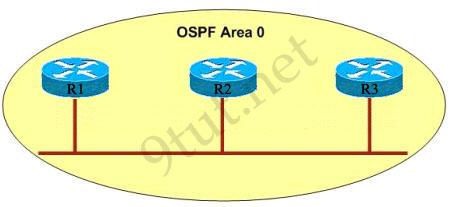
A – Configure EIGRP on these routers with a lower administrative distance B – All routers should be configured for backbone Area 1 C – R1 and R3 have been configured in different areas D – The hello and dead interval timers are not configured the same values on R1 and R3
Answer: C D
Question 2
Which parameter or parameters are used to calculate OSPF cost in Cisco routers?
A. Bandwidth, Delay and MTU B. Bandwidth C. Bandwidth and MTU D. Bandwidth, MTU, Reliability, Delay and Load
Answer: B
Explanation
The well-known formula to calculate OSPF cost is
Cost = 108 / Bandwidth
so B is the correct answer.
Question 3
A network administrator is troubleshooting the OSPF configuration of routers R1 and R2. The routers cannot establish an adjacency relationship on their common Ethernet link. The graphic shows the output of the show ip ospf interface e0 command for routers R1 and R2. Based on the information in the graphic, what is the cause of this problem?
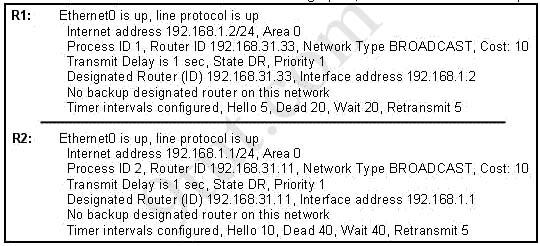
A. The OSPF area is not configured properly. B. The priority on R1 should be set higher. C. The cost on R1 should be set higher. D. The hello and dead timers are not configured properly. E. A backup designated router needs to be added to the network. F. The OSPF process ID numbers must match.
Answer: D
Explanation
A is not correct because configure EIGRP on these routers (with a lower administrative distance) will force these routers to run EIGRP, not OSPF.
B is not correct because the backbone area of OSPF is always Area 0.
C and D are correct because these entries must match on neighboring routers:
- Hello and dead intervals – Area ID (Area 0 in this case) – Authentication password – Stub area flag
Question 4
What information does a router running a link-state protocol use to build and maintain its topological database? (Choose two)
A. hello packets B. SAP messages sent by other routers C. LSAs from other routers D. beacons received on point-to-point links E. routing tables received from other link-state routers F. TTL packets from designated routers
Answer: A C
Question 5
Which command is used to display the collection of OSPF link states? A. show ip ospf link-state B. show ip ospf Isa database C. show ip ospf neighbors D. show ip ospf database
Answer: D
Question 6
When running OSPF, what would cause router A not to form an adjacency with router B?
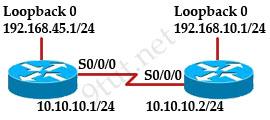
A. The loopback addresses are on different subnets. B. The values of the dead timers on the routers are different. C. Route summarization is enabled on both routers. D. The process identifier on router A is different than the process identifier on router
Answer: B
Explanation
To form an adjacency (become neighbor), router A & B must have the same Hello interval, Dead interval and AREA number.
CCNA EIGRP Questions
Question 1
A network administrator is troubleshooting an EIGRP problem on a router and needs to confirm the IP addresses of the devices with which the router has established adjacency. The retransmit interval and the queue counts for the adjacent routers also need to be checked. What command will display the required information?
A. Router# show ip eigrp adjacency B. Router# show ip eigrp topology C. Router#show ip eigrp interfaces D. Router#show ip eigrp neighbors
Answer: D
Explanation
Below is an example of the show ip eigrp neighbors command. The retransmit interval (Smooth Round Trip Timer – SRTT) and the queue counts (Q count, which shows the number of queued EIGRP packets) for the adjacent routers are listed:

Question 2
Refer to the exhibit. Based on the exhibited routing table, how will packets from a host within the 192.168.10.192/26 LAN be forwarded to 192.168.10.1?

A. The router will forward packets from R3 to R2 to R1 B. The router will forward packets from R3 to R1 C. The router will forward packets from R3 to R1 to R2 D. The router will forward packets from R3 to R2 to R1 AND from R3 to R1
Answer: D
Explanation
From the routing table we learn that network 192.168.10.0/30 is learned via 2 equal-cost paths (192.168.10.9 &192.168.10.5) -> traffic to this network will be load-balancing.
Question 3
Refer to the exhibit, when running EIGRP what is required for R1 to exchange routing updates with R3?
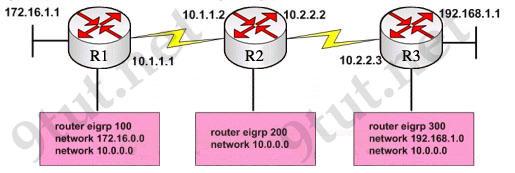
A – AS numbers must be changed to match on all the routers B – Loopback interfaces must be configured so a DR is elected C – The no auto-summary command is needed on R1 and R3 D – R2 needs to have two network statements, one for each connected network
Answer: A
Question 4
Which type of EIGRP route entry describes a feasible successor?
A. a primary route,stored in the routing table B. a backup route,stored in the routing table C. a backup route,stored in the topology table D. a primary route,stored in the topology table
Answer: C
Explanation
Feasible successor is a route whose Advertised Distance is less than the Feasible Distance of the current best path. A feasible successor is a backup route, which is not stored in the routing table but stored in the topology table.
Question 5
Refer to the exhibit. The company uses EIGRP as the routing protocol. What path will packets take from a host on 192.168.10.192/26 network to a host on the LAN attached to router R1?
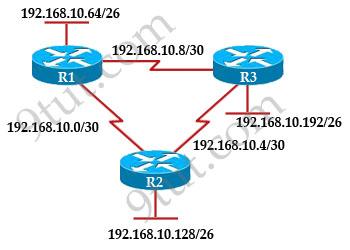
R3# show ip route Gateway of last resort is not set 192 168.10.0/24 is variably subnetted, 6 subnets, 2 masks D 192.168.10.64/26 [90/2195456] via 192.168.10.9, 00:03:31, Serial0/0 D 192.168.10.0/30 [90/2681856] via 192.168.10.9, 00:03:31, Serial0/0 C 192.168.10.4/30 is directly connected, Serial0/1 C 192.168.10.8/30 is directly connected, Serial0/0 C 192.168.10.192/26 is directly connected, FastEthernet0/0 D 192.168.10.128/26 [90/2195456] via 192.168.10.5,00:03:31, Serial0/1
A. The path of the packets will be R3 to R2 to R1. B. The path of the packets will be R3 to R1 to R2. C. The path of the packets will be both R3 to R2 to R1 and R3 to R1. D. The path of the packets will be R3 to R1
Answer: D
Explanation
Host on the LAN attached to router R1 belongs to 192.168.10.64/26 subnet. From the output of the routing table of R3 we learn this network can be reach via 192.168.10.9, which is an IP address in 192.168.10.8/30 network (the network between R1 & R3) -> packets destined for 192.168.10.64 will be routed from R3 -> R1 -> LAN on R1.
CCNA Security Questions
Question 1
Which Cisco Catalyst feature automatically disables the port in an operational PortFast upon receipt of a BPDU?
A. BackboneFast B. UplinkFast C. Root Guard D. BPDU Guard E. BPDU Filter
Answer: D
Explanation
We only enable PortFast feature on access ports (ports connected to end stations). But if someone does not know he can accidentally plug that port to another switch and a loop may occur when BPDUs are being transmitted and received on these ports.
With BPDU Guard, when a PortFast receives a BPDU, it will be shut down to prevent a loop -> D is correct.
Question 2
Which two commands correctly verily whether port security has been configured on port FastEthernet 0/12 on a switch? (Choose two)
A. SW1# show switchport port-security interface FastEthernet 0/12 B. SW1# show switchport port-secure interface FastEthernet 0/12 C. SW1# show port-security interface FastEthernet 0/12 D. SW1# show running-config
Answer: C D
Explanation
We can verify whether port security has been configured by using the “show running-config” or “show port-security interface ” for more detail. An example of the output of “show port-security interface ” command is shown below:
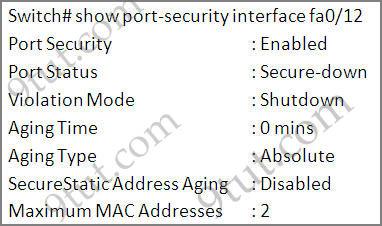
Question 3
Select the action that results from executing these commands:
Switch(config-if)# switchport port-security Switch(config-if)# switchport port-security mac-address sticky
A. A dynamically learned MAC address is saved in the startup-configuration file. B. A dynamically learned MAC address is saved in the running-configuration file. C. A dynamically learned MAC address is saved in the VLAN database. D. Statically configured MAC addresses are saved in the startup-configuration file if frames from that address are received. E. Statically configured MAC addresses are saved in the running-configuration file if frames from that address are received.
Answer: B
Explanation
The full syntax of the second command is:
switchport port-security mac-address sticky [MAC]
If we don’t specify the MAC address (like in this question) then the switch will dynamically learn the attached MAC Address and place it into your running-configuration -> B is correct.
Question 4
Refer to the exhibit. The following commands are executed on interface fa0/1 of 2950Switch.
2950Switch(config-if)#switchport port-security 2950Switch(config-if)#switchport port-security mac-address sticky 2950Switch(config-if)#switchport port-security maximum 1
The Ethernet frame that is shown arrives on interface fa0/1. What two functions will occur when this frame is received by 2950Switch? (Choose two)
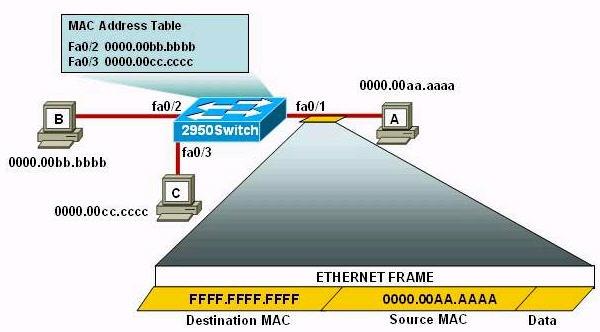
A. The MAC address table will now have an additional entry of fa0/1 FFFF.FFFF.FFFF. B. Only host A will be allowed to transmit frames on fa0/1. C. This frame will be discarded when it is received by 2950Switch. D. All frames arriving on 2950Switch with a destination of 0000.00aa.aaaa will be forwarded out fa0/1. E. Hosts B and C may forward frames out fa0/1 but frames arriving from other switches will not be forwarded out fa0/1. F. Only frames from source 0000.00bb.bbbb, the first learned MAC address of 2950Switch, will be forwarded out fa0/1.
Answer: B D
Explanation
Please read the explanation at http://www.9tut.net/icnd2/icnd2-operations
Question 5
Which set of commands is recommended to prevent the use of a hub in the access layer?
A. switch(config-if)#switchport mode trunk switch(config-if)#switchport port-security maximum 1
B. switch(config-if)#switchport mode trunk switch(config-if)#switchport port-security mac-address 1
C. switch(config-if)#switchport mode access switch(config-if)#switchport port-security maximum 1
D. switch(config-if)#switchport mode access switch(config-if)#switchport port-security mac-address 1
Answer: C
Explanation
Port security is only used on access port (which connects to hosts) so we need to set that port to “access” mode, then we need to specify the maximum number of hosts which are allowed to connect to this port -> C is correct.
Note: If we want to allow a fixed MAC address to connect, use the “switchport port-security mac-address ” command.
Question 6
Refer to the exhibit. A junior network administrator was given the task of configuring port security on SwitchA to allow only PC_A to access the switched network through port fa0/1. If any other device is detected, the port is to drop frames from this device. The administrator configured the interface and tested it with successful pings from PC_A to RouterA, and then observes the output from these two show commands.

Which two of these changes are necessary for SwitchA to meet the requirements? (Choose two)
A. Port security needs to be globally enabled. B. Port security needs to be enabled on the interface. C. Port security needs to be configured to shut down the interface in the event of a violation. D. Port security needs to be configured to allow only one learned MAC address. E. Port security interface counters need to be cleared before using the show command. F. The port security configuration needs to be saved to NVRAM before it can become active.
Answer: B D
Explanation
As we see in the output, the “Port Security” is in “Disabled” state (line 2 in the output). To enable Port security feature, we must enable it on that interface first with the command:
SwitchA(config-if)#switchport port-security
-> B is correct.
Also from the output, we learn that the switch is allowing 2 devices to connect to it (switchport port-security maximum 2) but the question requires allowing only PC_A to access the network so we need to reduce the maximum number to 1 -> D is correct.
Question 7
A network administrator needs to configure port security on a switch. Which two statements are true? (Choose two)
A. The network administrator can apply port security to dynamic access ports B. The network administrator can configure static secure or sticky secure mac addresses in the voice vlan. C. The sticky learning feature allows the addition of dynamically learned addresses to the running configuration. D. The network administrator can apply port security to EtherChannels. E. When dynamic mac address learning is enabled on an interface, the switch can learn new addresses up to the maximum defined.
Answer: C E
Question 8
Which protocol is an open standard protocol framework that is commonly used in VPNs to provide secure end-to-end connections?
A. PPTP B. IPsec C. RSA D. L2TP
Answer: B
Explanation
One of the most widely deployed network security technologies today is IPsec over VPNs. It provides high levels of security through encryption and authentication, protecting data from unauthorized access.
CCNA Operation Questions
Question 1
Which command would you use on a Cisco router to verify the Layer 3 path to a host? A. traced address B. traceroute address C. telnet address D. ssh address
Answer: B
Explanation
To check the connectivity between a host and a destination (through some networks) we can use both “tracert” and “ping” commands. But the difference between these 2 commands is the “tracert” command can display a list of near-side router interfaces in the path between the source and the destination. The “traceroute” command has the same function of the “tracert” command but it is used on Cisco routers only, not on a PC -> B is correct.
Question 2
Refer to the exhibit:
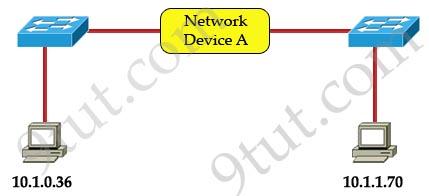
Which three statements correctly describe Network Device A? (Choose three)
A. With a network wide mask of 255.255.255.128, each interface does not require an IP address. B. With a network wide mask of 255.255.255.128, each interface does require an IP address on a unique IP subnet. C. With a network wide mask of 255.255.255.0, must be a Layer 2 device for the PCs to communicate with each other. D. With a network wide mask of 255.255.255.0, must be a Layer 3 device for the PCs to communicate with each other. E. With a network wide mask of 255.255.254.0, each interface does not require an IP address.
Answer: B D E
